Content
Burnet in landscape design is a plant that began to be used not so long ago, when decorative qualities were appreciated. Before that, the culture was only used in cooking, as well as for medicinal purposes. And thanks to this, it got its name, as it has a hemostatic effect. In botanical reference books, this culture is described as Sanguisorba. Under natural conditions, it can be found on the territory of Eurasia, North America, in the foothills of the Tien Shan, the Caucasus.
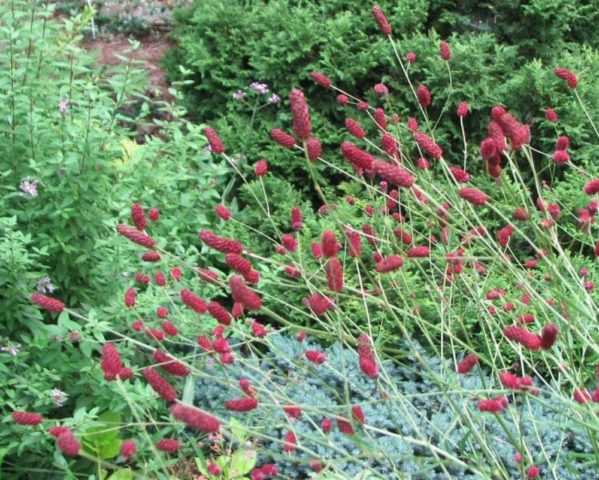
On the plates of the plant, a relief mesh of veins is clearly distinguished
What does a burnet look like
Sangvisorba is a herbaceous perennial, the height of which reaches 0.5-1.8 m. Burnet is characterized by thin long shoots, hollow inside, with branches. On them are rare odd-pinnate petiole leaves of a small size. Larger plates are found in the lower part of the plant, where they form a loose root rosette. Burnet leaves have an ovoid shape, the surface is folded, there is a slight serration at the edges. The upper side of the plates has a rich green color, and the back side has a bluish bloom. With the arrival of autumn, the leaves of the burnet take on a bright shade.
Burnet root system is thickened, lignified, superficial. It is covered with dark brown cracked bark. The main root deepens by 12 cm, and the lateral processes grow in breadth by 20-30 cm, depending on the age of the perennial.
Burnet flowering period begins in the middle of summer and lasts at least 2 months. At this time, a single apical spicate or capitate inflorescence 1-7 cm long and 1 cm in diameter is formed on each shoot. It consists of small flowers that are closely pressed. Their color can be pale pink, white and muted red.
The structure of flowers in the burnet is special. They consist only of stamens, and the petals replace the bracts. In the center there is a clavate pistil, framed in the lower part by an ovary.
After pollination, the flowers gradually wither. In their place, fruits are formed, which are smooth pear-shaped single-seeded nuts of dark brown color. Subsequently, they are carried by the wind, and so the plant spreads.
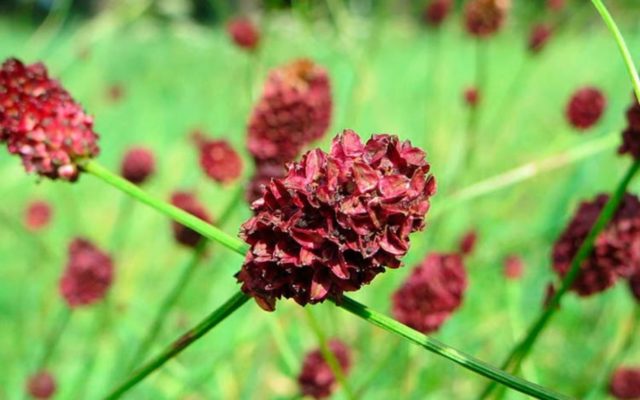
Burnet - a member of the Rosaceae family
Types and varieties of burnet
In nature, there are about 20 different species of this plant. But only some of them are characterized by a long flowering period and increased resistance to any climatic conditions. Therefore, they became the basis for the development of decorative forms of burnet.
Alpine
A medium-sized type of burnet, in which the shoots are strongly branched, unlike the rest. Heart-shaped leaf plates, rich green color. The drooping inflorescences do not exceed 2 cm at the beginning of flowering, but then noticeably lengthen. Their color is white-green. The budding period of the Alpine Burnet begins in June.
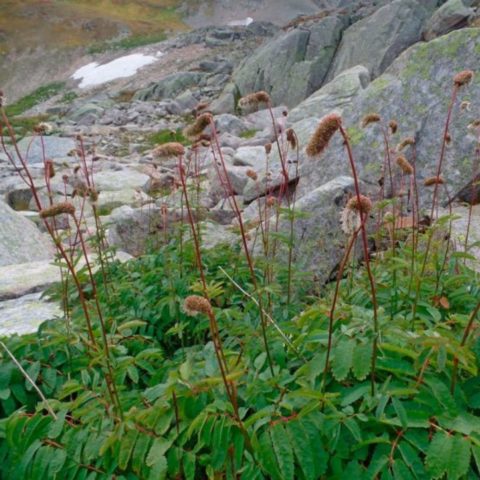
Alpine variety easily adapts to a new location
Dumb
A Japanese variety found in the highlands. Blunt Burnet (Sanguisorba obtusa) is characterized by compact bushes up to 1.0 m in height. Its shoots branch out at the base. Lush drooping inflorescences with numerous pink pistils. This type looks spectacular in group plantings with dark species.
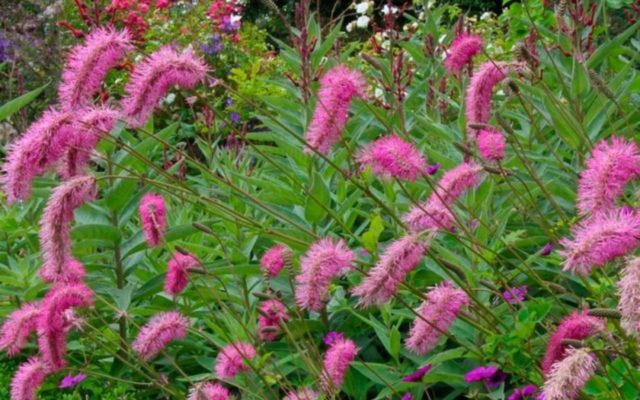
The shade of inflorescences in a blunt burnet later brightens
Canadian
A tall type of culture, reaching 180 cm. The diameter of the bushes is about 60 cm. The leaves are narrow, elongated, pointed at the ends. Their shade is light green. Inflorescences are spiky white or cream color. The Canadian Burnet (Sanguisorba Canadensis) blooms in June. This period lasts for her 1.5 months.
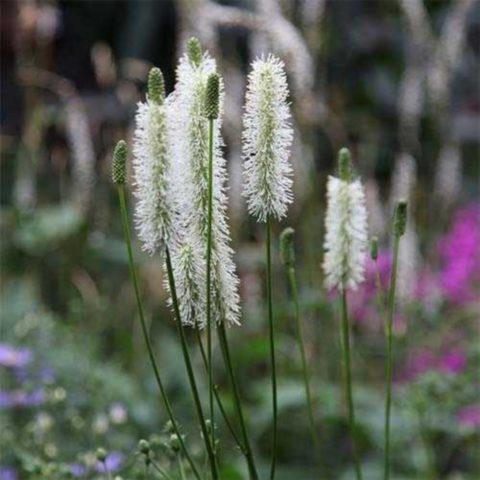
The Canadian crop is ideal for cutting
Medicinal
This variety is most often used for medicinal purposes. Burnet medicinal (Sanguisorba officinalis) is characterized by erect shoots 1.0-1.5 m high. Peduncles in this variety are oval-capitate up to 3 cm long. Their shade can be of 2 types: burgundy, purple.
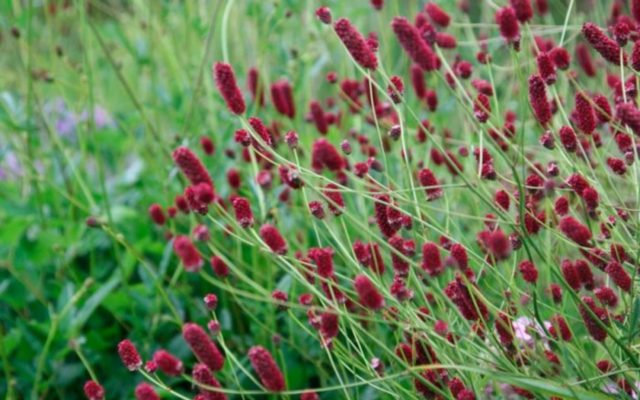
Due to a sharp decline in the number, medicinal burnet is listed in the Red Book
Small-flowered
A large herbaceous shrub, the height of which varies from 60 to 120 cm, depending on the growing conditions. In the lower part of the small-flowered burnet (Sanguisorba parviflora) there are petiolar leaves up to 25-30 cm long, and on thin shoots - narrow-lanceolate, serrate. The color of drooping inflorescences in this species is greenish-white.
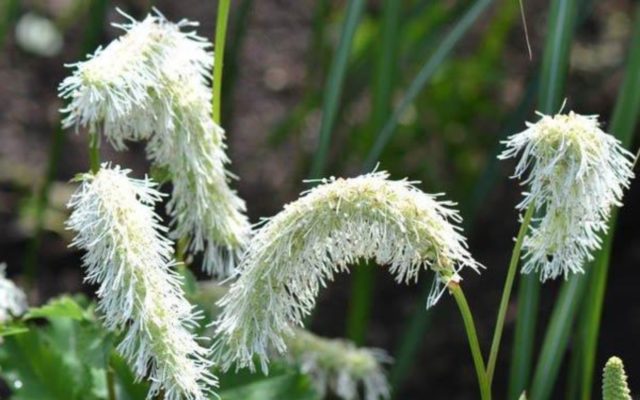
Small-flowered burnet is an excellent honey plant
Small
A low-growing type of culture with compact bushes 30-40 cm. It is widely used in cooking for the preparation of salads, soups, cold drinks. The shoots of the Lesser Burnet (Sanguisorba minor) have a cucumber-nut flavor, which gives an exquisite touch to the dishes. The capitate inflorescences of the plant are burgundy.
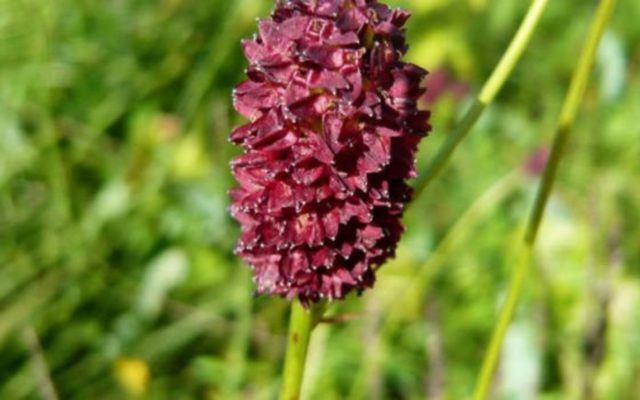
Small Burnet is ideal as a seasoning for salmon
Burnet of Menzies
This species is distinguished by bushes up to 120 cm high and about 60 cm in diameter. The Menzies Burnet (Sanguisorba menziesii) is distinguished by large elongated leaves that form a basal rosette of a greenish-gray hue. The inflorescences of the plant are spike-shaped up to 7 cm long in a rich purple-pink tone.
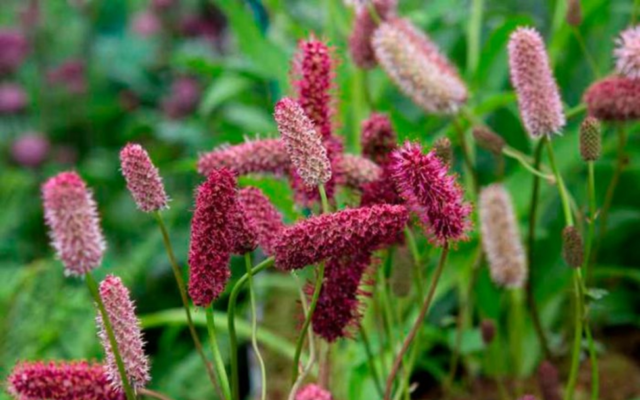
Menzies' Burnet bloom in mid-June
Burnet is magnificent
An average type of culture with a height of bushes up to 70 cm and a diameter of about 45 cm. Magnificent Burnet (Sanguisorba magnifica) has unpaired glaucous leaves. Inflorescences are spike-shaped, large, up to 7 cm long. Their color is pink. The plant blooms in early June and continues for a month.
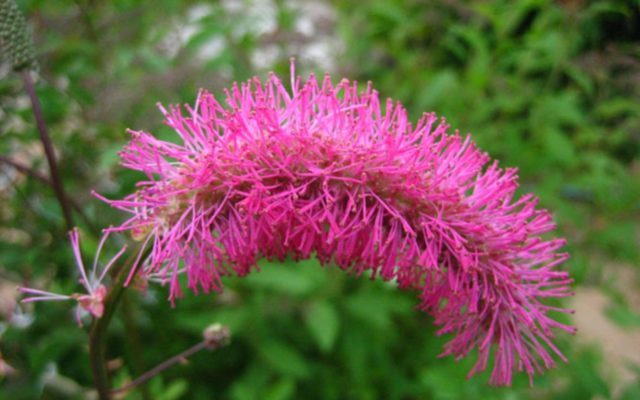
The inflorescences of the magnificent burnet are reminiscent of alder catkins
The best varieties
In landscape design, decorative varieties of burnet have gained particular popularity, which are distinguished by increased frost resistance and long flowering for 2 months. These qualities allow them to be used for landscaping the site in group and single plantings, as well as in combination with other crops. Among the hybrid forms of the plant, the variegated burnet is also found.
Rhesus
This variety is characterized by short stature. The height of its bushes varies from 18 to 30 cm, depending on climatic conditions. Its root outlet is raised. Leaves of medium size, rich green shade, pinnately dissected. Inflorescences in the form of club-shaped heads of dark pink color. This creates a great contrasting combination with foliage. Therefore, this variety is very popular with landscape designers.
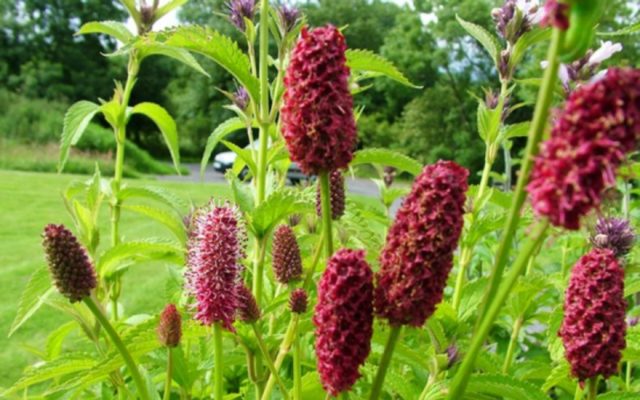
The Rhesus variety blooms in early July.
Pink Brashes
A graceful plant with drooping spike-shaped inflorescences of a pale pink hue. Their length reaches 7 cm. Leaves are dissected, light green in color. The maximum decorative effect can be achieved by planting this variety in an open area with light shading at midday. The height of the shrub reaches 60-80 cm. Flowering occurs at the end of July and continues until October.Pink Brushes is ideal for framing garden paths and can also be grown as a pot crop.

The shade of the leaves at Pink Brasses does not change with the arrival of autumn
Chocolate tip
A novelty variety that stands out from the rest with its dense, fluffy inflorescences of a pleasant brown shade. Their length reaches 3 cm. They rise on thin shoots at a height of 1 m. The color of the leaves of this species is light green. This creates an effective contrasting combination with dark inflorescences. The chocolate tip is characterized by an average level of frost resistance, therefore it is recommended to grow it in the central and southern regions.

Burnet Chocolates are hard to find on sale
Tanna and Pink Tanna
Two identical species that differ in the shade of the inflorescences. In one variety, they are maroon, while in the other, they are bright pink. The height of the shrub reaches 100-120 cm. The leaves are pinnately dissected, dark green saturated color. The flowering period begins in July and lasts until September. In the Pink Tanna burnet, the inflorescences are erect, while in the Tanna they are drooping.
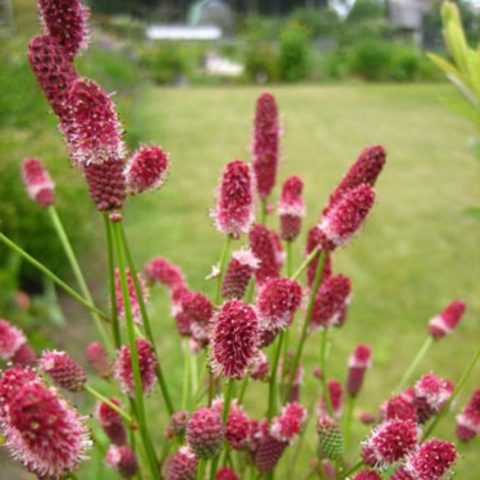
For group plantings, place burnet seedlings 3-4 pcs. for 1 sq. m
Red Zander
A compact crop variety with excellent decorative qualities. The height of the shrub of this variety does not exceed 60 cm. This allows the plant to be used in mixborders and for the foreground in multi-level compositions. Flowering begins in June and lasts until the end of August. The variety is also characterized by high frost resistance. Peduncles at Red Sandler (Red Thunder) in the form of dense cones of maroon color.

Red Zander is suitable for growing in northern regions
Menzies
A tall variety, the bushes of which reach 95-100 cm. It is characterized by thin erect shoots. Burnet of Menzies (Menziesii) is distinguished by spike-shaped inflorescences of a dark red hue. Possesses good frost resistance. This species blooms in July and lasts until mid-October.
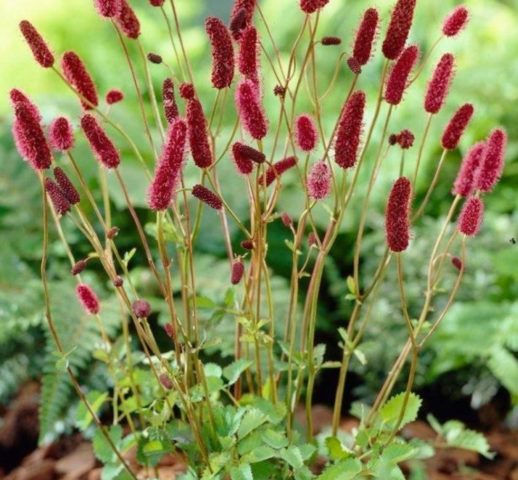
Menzies goes well with shrubs with dark foliage
Little Angel
Variegated decorative crop variety. The name of the burnet Little Angel fully justifies the appearance of a perennial. The variety is characterized by compact graceful bushes, the height of which reaches 30-35 cm. The decoration of the plant is bluish-gray leaves with a white frame along the edge of the plates. Burnettle Little Angel is also characterized by bright pink-red buds in the form of cones.
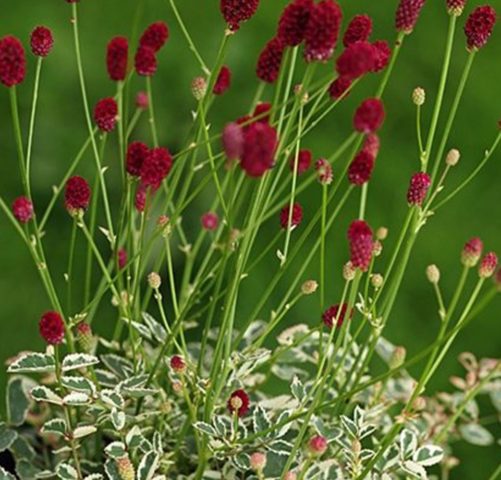
Little Angel looks good in combination with ground covers and low grains
Burnet in landscape design
The variety of ornamental plant species allows it to be widely used for landscaping areas. Burnet looks good in group plantings. Landscape designers recommend using tall varieties as a background in multi-level flower beds, which completes the composition. Low types of burnet are recommended for creating alpine slides.
This plant is ideally combined with lilies, cereals, astilbe. Can also be planted with daylilies, basilisks, meadowsweet and mountaineers.
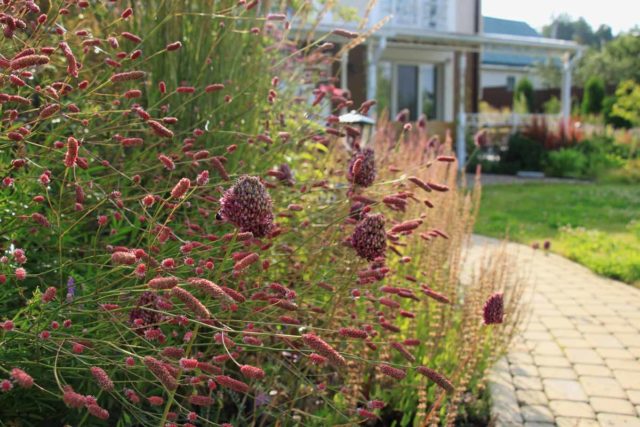
Burnet looks spectacular as a frame for garden paths
Reproduction methods
To obtain new burnet seedlings, you can use the seed method and dividing the bush.
In the first case, planting is recommended to be carried out immediately in open ground before winter after collecting the seed. To do this, it is necessary to dig up the site in advance and level the soil surface. Then evenly sprinkle the seeds into the holes and cover them with a layer of peat 1-2 cm, water abundantly. With the arrival of spring, friendly shoots appear, which are not afraid of weeds and possible temperature changes.In the fall, grown seedlings can be transplanted to a permanent place with a lump of earth on the roots.
To obtain 2-3 new seedlings, you can use the division of the bush. This breeding method should be used in May, during the active growing season, or in August, after flowering. To do this, you need to dig up the plant and carefully clean its lower part from the ground. Then, with a sharp knife or a shovel, divide into divisions, each of which should have a growth point and well-developed root processes. At the end of the procedure, they should be immediately planted in a permanent place and watered abundantly.
Planting and leaving
This plant is classified as an undemanding crop. Therefore, any grower can cope with its cultivation, even without many years of experience. In order for the plant to quickly adapt and grow, it is necessary to familiarize yourself with some of the rules for planting and caring for the burnet.
Landing terms and rules
It is necessary to plant a shrub in open ground in the spring, when the earth warms up enough, or in early autumn, so that the burnet has time to take root before frost. For a perennial, you need to choose a sunny place or in partial shade, protected from drafts. The culture prefers to grow in organic-rich soil. Therefore, before planting in the ground, you need to add humus at the rate of 10 kg per 1 sq. m.
The holes for the burnet must be prepared in the size of 30 by 30 cm. Drainage should be laid at the bottom, and the rest of the space should be filled with a soil mixture of turf, peat and sand in a ratio of 2: 1: 1. In the center of the recess, make a small elevation on which to place the seedling without deepening its root collar. After that, sprinkle with earth and compact the soil at the base, and then water abundantly.
Growing and caring for burnet
This culture does not need complex care. Watering should be carried out 1-2 times a week with the soil soaking up to 10 cm. After each irrigation, it is recommended to loosen the soil at the base of the plant in order to maintain air access to the roots.
It is necessary to weed the burnet plantings only at the initial stage, since when the seedlings get stronger, they suppress the growth of weeds on their own.
You need to feed the shrub twice a season. The first time during the active growing season in the spring. At this time, nitroammofoska should be used at the rate of 30 g per 10 l of water or organic matter 1:10. The second time to fertilize the burnet is necessary when forming peduncles. During this period, superphosphate (30 g) and potassium sulfide (20 g) should be applied to a bucket of water.
Preparing for winter
Burnet does not need special preparation for wintering. This plant easily tolerates frosts down to -30 degrees without any shelter. But young seedlings are not so resistant. Therefore, until the age of three, they need to be mulched for the winter with a layer of peat and sprinkled with fallen leaves.
Diseases and pests
Cases of infection of this culture by fungal diseases and pests have not been identified. But sometimes on the leaves of the burnet you can see mosaic spots and light streaks, which is a sign of a virus. In this case, the affected bushes should be dug up and burned to prevent further spread.
Conclusion
Burnet in landscape design is an ideal plant that does not require difficult maintenance and retains its decorative effect throughout the season. Therefore, any gardener, even without experience, can cope with the cultivation of a perennial. In addition, this culture can be used in cooking and for the treatment of many diseases, subject to possible contraindications. Therefore, we can say about the burnet that it is not only a highly decorative, but also a useful plant.
https://youtu.be/UG7fOV5gNHQ








